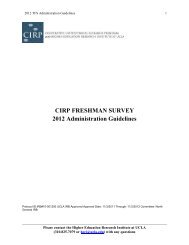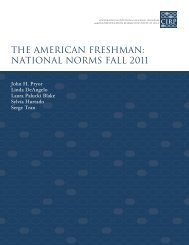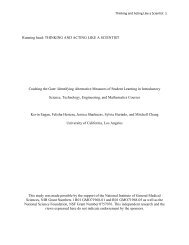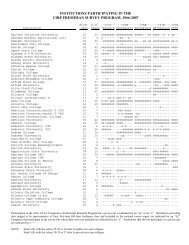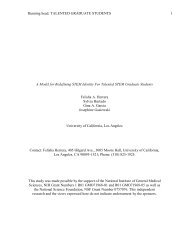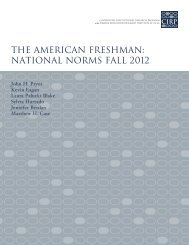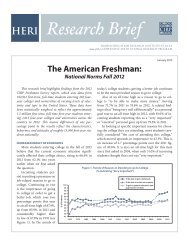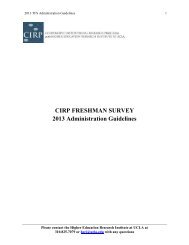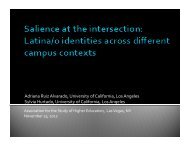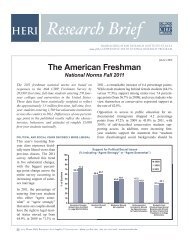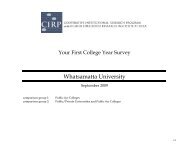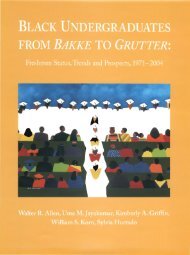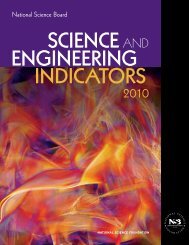North Dakota University System - Higher Education Research Institute
North Dakota University System - Higher Education Research Institute
North Dakota University System - Higher Education Research Institute
Create successful ePaper yourself
Turn your PDF publications into a flip-book with our unique Google optimized e-Paper software.
Introduction<br />
During the 1998-99 academic year, <strong>North</strong> <strong>Dakota</strong>’s eleven public campuses participated<br />
in the <strong>Higher</strong> <strong>Education</strong> <strong>Research</strong> <strong>Institute</strong>’s (HERI) Faculty Survey. This survey was<br />
the fourth in a series of faculty surveys conducted on a triennial basis by the HERI. In<br />
addition to demographic and biographic information, the questionnaire for the 1998-99<br />
Faculty Survey focused on how faculty members’ demographics, how they spent their<br />
time, their publications and creative productions, goals, their preferred methods of<br />
teaching and examining students, their perceptions of the institutional climate, and their<br />
primary sources of stress and satisfaction. The 1998-99 instrument also included eight<br />
new items relating to faculty’s experiences with information technology.<br />
The <strong>North</strong> <strong>Dakota</strong> <strong>University</strong> <strong>System</strong> (NDUS) was particularly interested in separately<br />
identifying characteristics of NDUS faculty for three categories: faculty at doctorategranting<br />
institutions, faculty at other four-year institutions, and faculty at two-year<br />
institutions.<br />
This report summarizes the results of the HERI Faculty Survey related to demographics,<br />
faculty time, publications and creative productions, instructional technology, goals,<br />
perceptions, and job-related stressors and satisfaction. Questions included:<br />
1. What are the general characteristics of faculty in <strong>North</strong> <strong>Dakota</strong>’s eleven public<br />
higher education institutions?<br />
2. Do faculty differ by institutional type?<br />
3. How do <strong>North</strong> <strong>Dakota</strong> faculty compare to faculty in similar institutions across the<br />
United States 1 ?<br />
Sample<br />
The overall survey response rate for the eleven institutions was 59.5 percent (see Table<br />
1). Of 1,563 questionnaires mailed out to NDUS faculty, usable returns were eventually<br />
received from 930 (Personal communication, Bill Korn, October 4, 1999). This response<br />
rate was high, especially when considering that the response rate for all institutions<br />
nationally was 43 percent.<br />
Only those full-time faculty who were engaged in teaching undergraduates were included<br />
in the normative data for the Faculty Survey and in this report for the NDUS. Thus, full-<br />
1 In this report, the doctorate-granting institutions (<strong>University</strong> of <strong>North</strong> <strong>Dakota</strong>, <strong>North</strong> <strong>Dakota</strong> State<br />
<strong>University</strong>) will be compared to the national norms for public universities. The institutions which are<br />
primarily four-year institutions (Dickinson State <strong>University</strong>, Mayville State <strong>University</strong>, Minot State<br />
<strong>University</strong>, Valley City State <strong>University</strong>) will be compared to the national norms for public four-year<br />
colleges. The two-year institutions (Bismarck State College, Minot State <strong>University</strong>-Bottineau Campus,<br />
<strong>North</strong> <strong>Dakota</strong> State College of Science, Williston State College, Lake Region State College) will compared<br />
to the national norms for public two-year colleges.<br />
3



